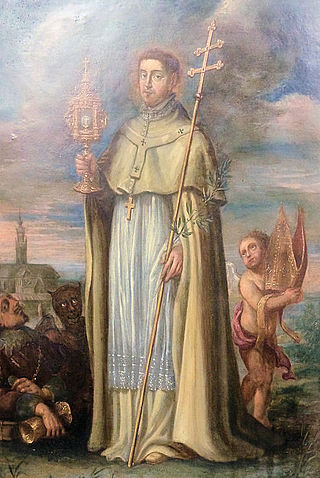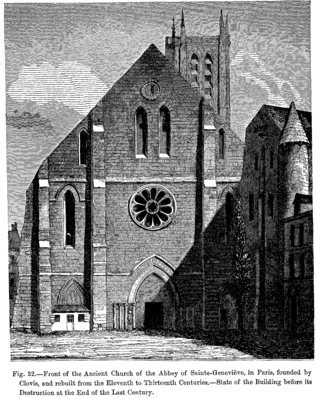Related Research Articles

Noyon is a commune in the Oise department, northern France.

Tournai or Tournay is a city and municipality of Wallonia located in the Province of Hainaut, Belgium. It lies 89 km (55 mi) by road southwest of the centre of Brussels on the river Scheldt, and is part of Eurometropolis Lille–Kortrijk–Tournai, In 2022, the municipality of Tournai had an estimated population of 68,518 people.

The term Black Madonna or Black Virgin tends to refer to statues or paintings in Western Christendom of the Blessed Virgin Mary and the Infant Jesus, where both figures are depicted with dark skin. Examples of the Black Madonna can be found both in Catholic and Orthodox countries.

Ulysse Chevalier was a French bibliographer and historian.

Norbert of Xanten, O. Praem (Xanten-Magdeburg), also known as Norbert Gennep, was a bishop of the Catholic Church, founder of the Premonstratensian order of canons regular, and is venerated as a saint. Norbert was canonized by Pope Gregory XIII in the year 1582, and his statue appears above the Piazza colonnade of St. Peter's Square in Rome.

Laon Cathedral is a Roman Catholic church located in Laon, Aisne, Hauts-de-France, France. Built in the twelfth and thirteenth centuries, it is one of the most important and stylistically unified examples of early Gothic architecture. The church served as the cathedral of the Diocese of Laon until 1802, and has been recognized as a monument historique since 1840.

The Order of Canons Regular of Prémontré, also known as the Premonstratensians, the Norbertines and, in Britain and Ireland, as the White Canons, is a religious order of canons regular of the Catholic Church founded in Prémontré near Laon in 1120 by Norbert of Xanten, who later became Archbishop of Magdeburg. Premonstratensians are designated by OPraem following their name.

Rocamadour is a commune in the Lot department in southwestern France. It lies in the former province of Quercy.

Christchurch Priory is an ecclesiastical parish and former priory church in Christchurch in the English county of Dorset. It is one of the longest parish churches in the country and is as large as many of the Church of England Cathedrals.

Chauny is a commune in the Aisne department in Hauts-de-France in northern France.
Peter Cantor, also known as Peter the Chanter or by his Latin name Petrus Cantor, was a French Roman Catholic theologian. He received his education at Rheims, and later moved on to Paris, where, in 1183, he became Chanter at Notre Dame. Charters show Petrus Cantor as a man active in hearing cases, witnessing documents and participating in the business of the chapter of Notre Dame. Petrus was elected dean at Reims in 1196, but died in the following year in the Longpont Abbey, some time after 29 January 1197. He commented on Old Testament and New Testament books. His work on the sacrament of penance is especially noteworthy. His work reflects Scholastic perspectives.

The Diocese of Soissons, Laon, and Saint-Quentin is a Latin Church diocese of the Catholic Church in France. The diocese is suffragan to the Archdiocese of Reims and corresponds, with the exception of two hamlets, to the entire Department of Aisne. The current bishop is Renauld Marie François Dupont de Dinechin, appointed on 30 October 2015. In the Diocese of Soissons there is one priest for every 4,648 Catholics.

Thomas of Marle, Lord of Coucy and Boves, was a medieval French nobleman. He was born in 1073 to Enguerrand I of Boves, the Lord of Coucy, and his wife Adele of Marle. After the death of his father, Thomas became the Lord of Coucy and of his family's other holdings. As the best-known of the Lords of Coucy, Thomas of Marle became infamous for his aggressive and brutal tactics in war and his continued rebellion against the authority of King Louis VI.

The Abbey of Saint Genevieve was a monastery in Paris. Reportedly built by Clovis, King of the Franks in 502, it became a centre of religious scholarship in the Middle Ages. It was suppressed at the time of the French Revolution.

Liège Cathedral, otherwise St. Paul's Cathedral, is a Roman Catholic cathedral in Liège, Belgium. Founded in the 10th century, it was rebuilt from the 13th to the 15th century and restored in the mid-19th century. It became a Catholic cathedral in the 19th century due to the destruction of Saint Lambert's Cathedral in 1795. It is the seat of the Diocese of Liège.
Herman of Tournai, Herman of Laon or Hériman of Tournai,, the third abbot of Saint Martin of Tournai, was a chronicler of his abbey and, in many anecdotal accounts connected with the abbey, a social historian of the world seen from its perspective. Forced from his abbacy in 1136 by a contingent within the monastic community that asserted he had been lax in his enforcement of the Benedictine rule, he had the leisure while at Rome to write his book, Restauratio sancti Martini Tornacensis, written in Latin about fifty years after a local plague of 1090. He was a pupil of Odoardus, later Bishop of Cambrai, whose example as a teacher he delineates at the start of his work, and who was the driving force behind the refounding of a neglected and undistinguished church dedicated to St Martin of Tours near Tournai. Herman's Restauratio has been edited and translated for the first time into English by Lynn Harry Nelson, who provided extended explanatory notes.

Barthélemy de Jur was a French bishop. He was bishop of Laon from 1113 to 1151. Some documents give his name as Barthélemy de Grandson or de Joux.

Philip II, called Philippe de Méréville or Philippe de Nemours, was the bishop of Châlons from 1228 until his death. He was a member of the nobility of the Île-de-France, and was a priest in Paris before coming to Châlons. As bishop, he was a consistent ally of Count Theobald IV of Champagne, in whose county his diocese lay.
De miraculis sanctae Mariae Laudunensis, generally ascribed to Herman of Tournai, is a Latin work written in the 1140s which describes two fundraising tours of northern France and southern England made by the canons of Laon Cathedral in 1112 and 1113, and presents a eulogy of Laon's bishop, Barthélemy de Jur. Its incidental mentions of Cornish folklore about King Arthur, including belief in his survival, have attracted great interest from Arthurian scholars, but it is also a valuable historical source on the state of English and French society in the early 12th century.
Helinand was the bishop of Laon from 1052 to 1098.
References
- ↑ Guibert of Nogent (2011). Monodies and On the Relics of Saints. Penguin Books Ltd. pp. 153–154. ISBN 978-0-14-310630-2.
- ↑ Turville-Petre, Gabriel (1972). Nine Norse Studies. London: University College London, for the Viking Society for Northern Research. pp. 64–78.
- ↑ Hanna, Katharine (2007). The Christchurch Priory Cartulary. The Castle, Winchester, SO23 8UJ: Hampshire County Council. ISBN 978-1-85975-761-1.
{{cite book}}: CS1 maint: location (link) - ↑ Tatlock, J S P (1933). Speculum, Vol. 8, No. 4: The English Journey of the Laon Canons. The Medieval Academy of America.
- ↑ Harte, Jeremy (1985). The Dragon of Christchurch and Other Wonders Seen on a Journey Through the West of England in 1113. South-Western Antiquarian Society.
- ↑ Saint-Denis, Alain (2008). Les Miracles de Sainte Marie de Laon. CNRS Éditions, Paris. pp. 175–180. ISBN 978-2-271-06567-4.